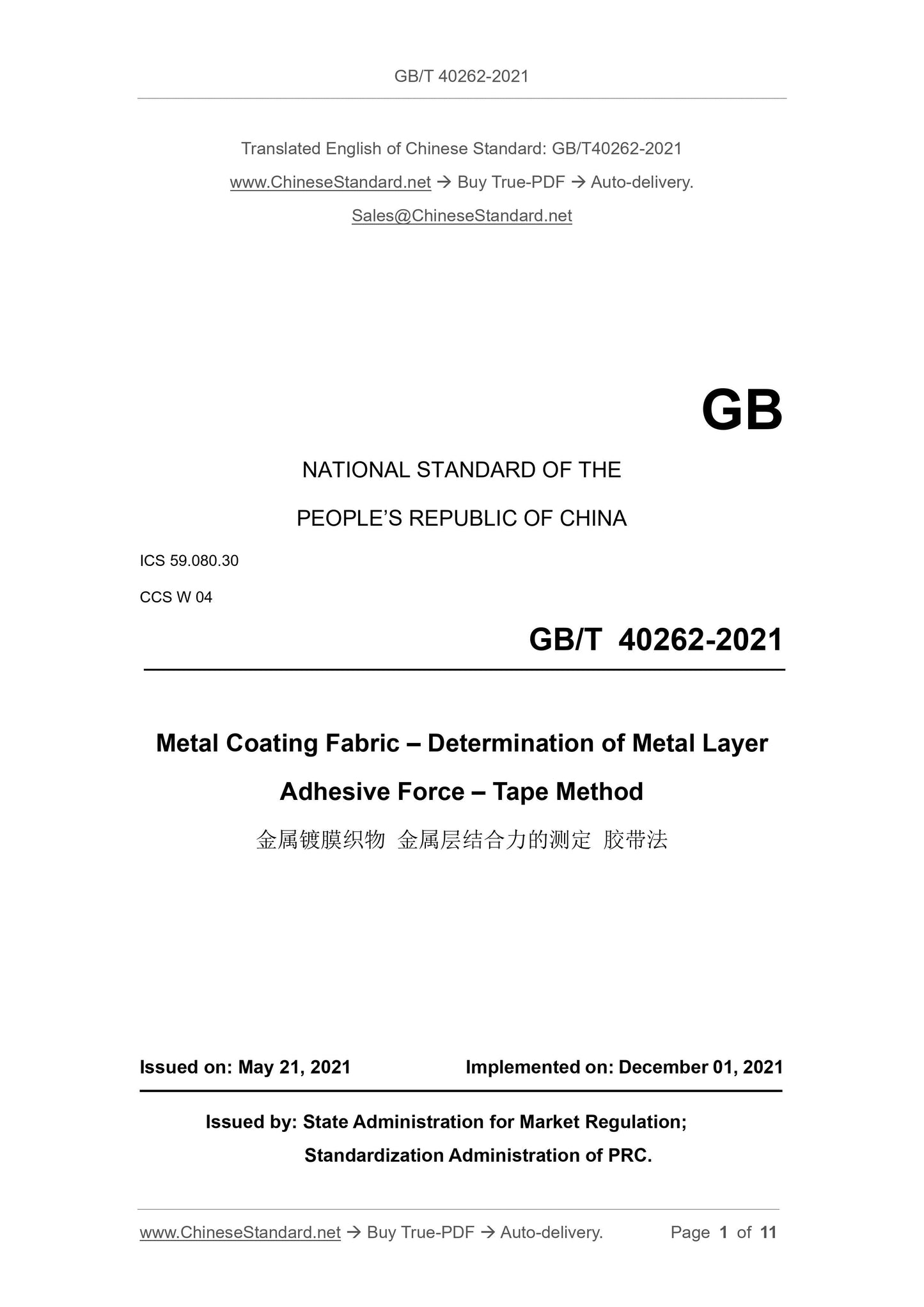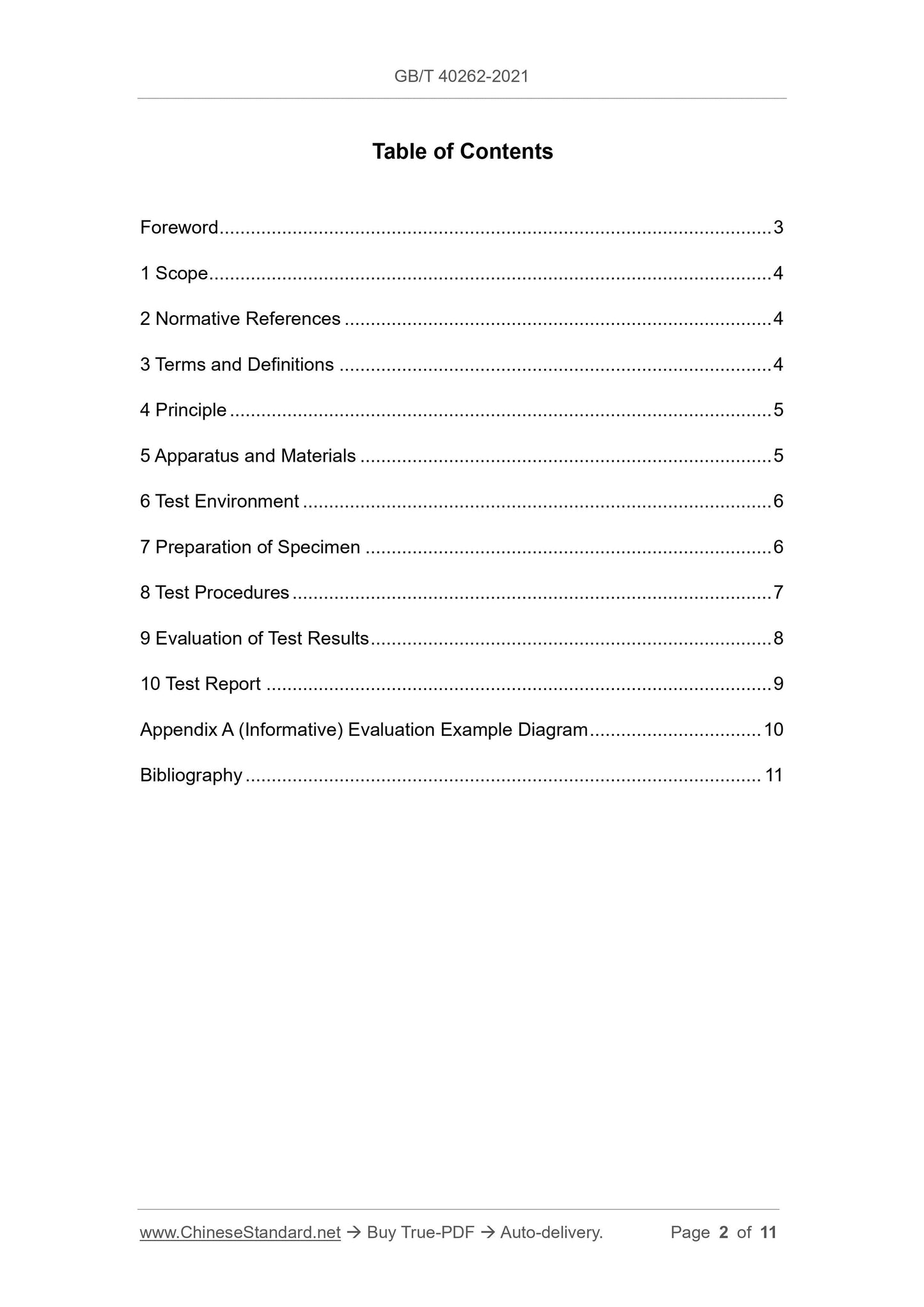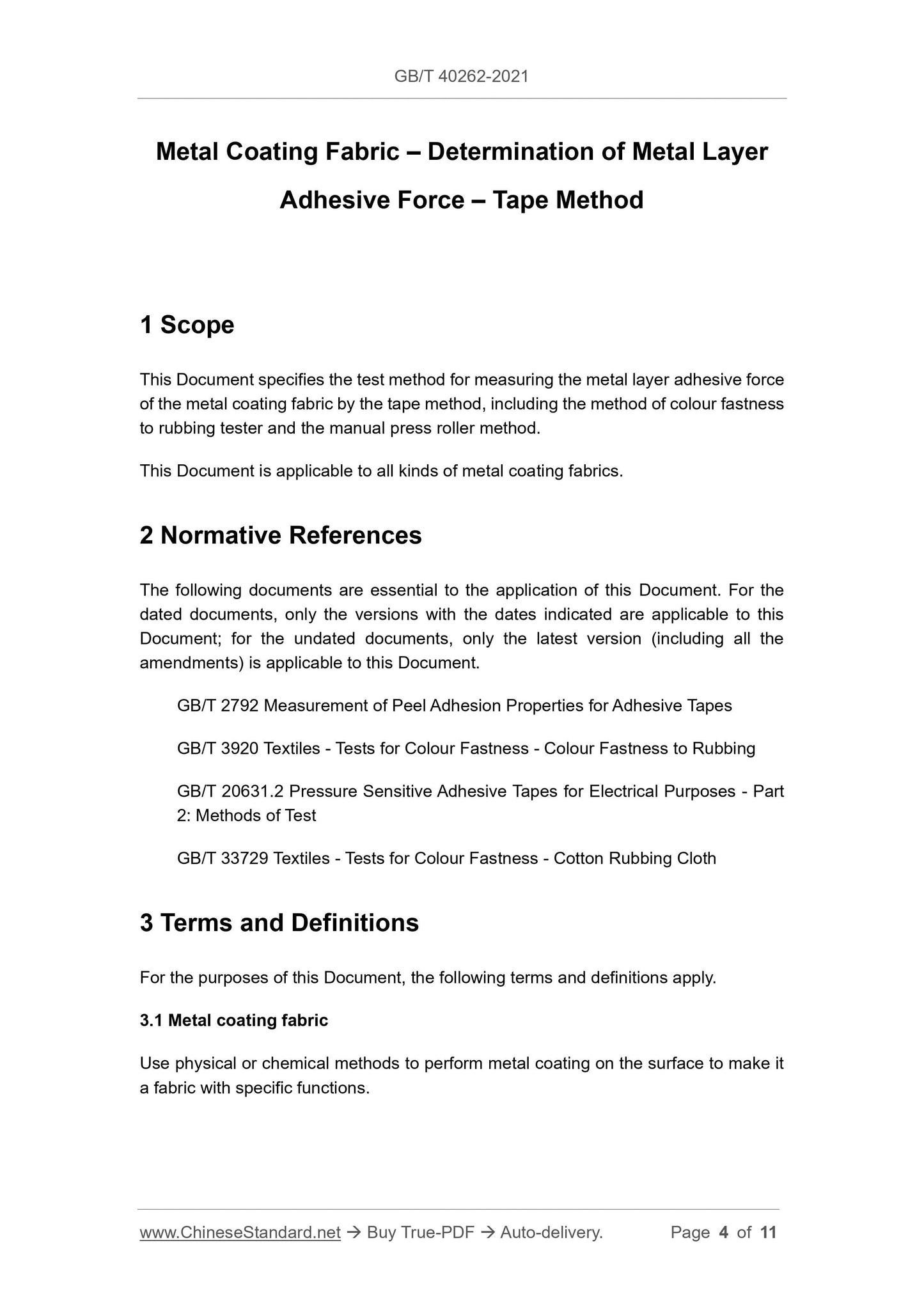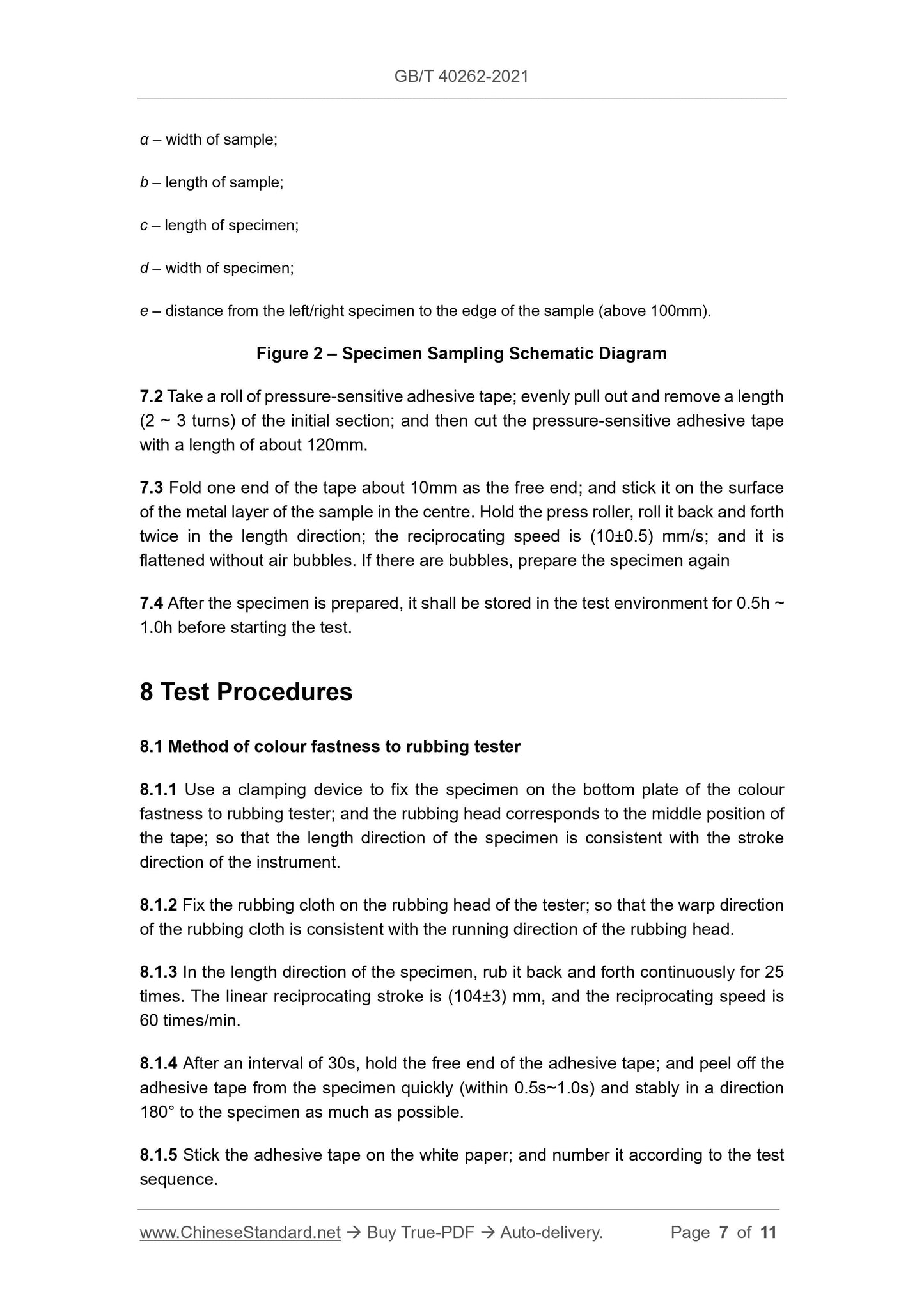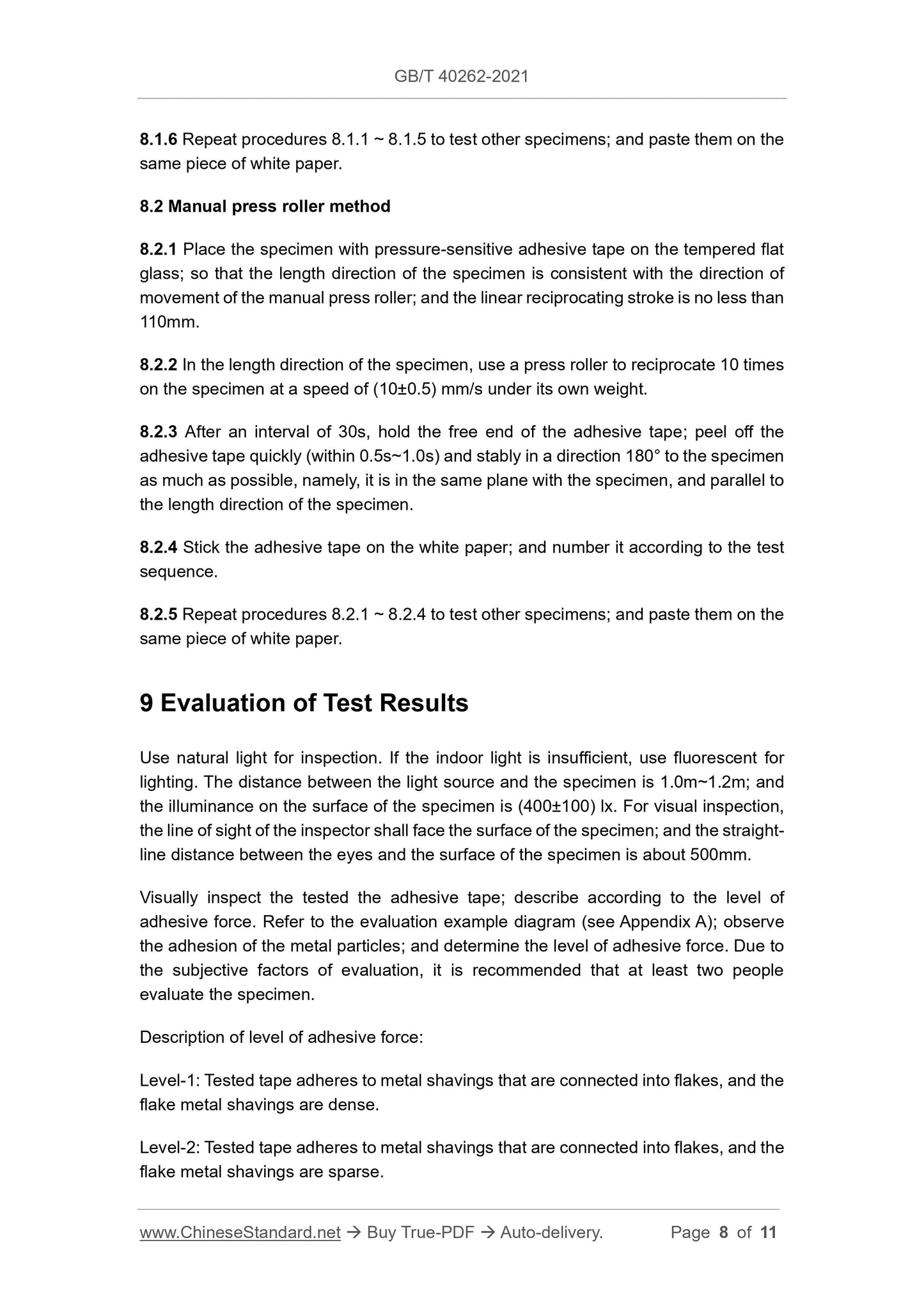1
/
of
5
www.ChineseStandard.us -- Field Test Asia Pte. Ltd.
GB/T 40262-2021 English PDF (GB/T40262-2021)
GB/T 40262-2021 English PDF (GB/T40262-2021)
Regular price
$185.00
Regular price
Sale price
$185.00
Unit price
/
per
Shipping calculated at checkout.
Couldn't load pickup availability
GB/T 40262-2021: Metal coating fabric - Determination of metal layer adhesive force - Tape method
Delivery: 9 seconds. Download (& Email) true-PDF + Invoice.
Get Quotation: Click GB/T 40262-2021 (Self-service in 1-minute)
Historical versions (Master-website): GB/T 40262-2021
Preview True-PDF (Reload/Scroll-down if blank)
GB/T 40262-2021
GB
NATIONAL STANDARD OF THE
PEOPLE’S REPUBLIC OF CHINA
ICS 59.080.30
CCS W 04
Metal Coating Fabric – Determination of Metal Layer
Adhesive Force – Tape Method
ISSUED ON: MAY 21, 2021
IMPLEMENTED ON: DECEMBER 01, 2021
Issued by: State Administration for Market Regulation;
Standardization Administration of PRC.
Table of Contents
Foreword ... 3
1 Scope ... 4
2 Normative References ... 4
3 Terms and Definitions ... 4
4 Principle ... 5
5 Apparatus and Materials ... 5
6 Test Environment ... 6
7 Preparation of Specimen ... 6
8 Test Procedures ... 7
9 Evaluation of Test Results ... 8
10 Test Report ... 9
Appendix A (Informative) Evaluation Example Diagram ... 10
Bibliography ... 11
Metal Coating Fabric – Determination of Metal Layer
Adhesive Force – Tape Method
1 Scope
This Document specifies the test method for measuring the metal layer adhesive force
of the metal coating fabric by the tape method, including the method of colour fastness
to rubbing tester and the manual press roller method.
This Document is applicable to all kinds of metal coating fabrics.
2 Normative References
The following documents are essential to the application of this Document. For the
dated documents, only the versions with the dates indicated are applicable to this
Document; for the undated documents, only the latest version (including all the
amendments) is applicable to this Document.
GB/T 2792 Measurement of Peel Adhesion Properties for Adhesive Tapes
GB/T 3920 Textiles - Tests for Colour Fastness - Colour Fastness to Rubbing
GB/T 20631.2 Pressure Sensitive Adhesive Tapes for Electrical Purposes - Part
2: Methods of Test
GB/T 33729 Textiles - Tests for Colour Fastness - Cotton Rubbing Cloth
3 Terms and Definitions
For the purposes of this Document, the following terms and definitions apply.
3.1 Metal coating fabric
Use physical or chemical methods to perform metal coating on the surface to make it
a fabric with specific functions.
α – width of sample;
b – length of sample;
c – length of specimen;
d – width of specimen;
e – distance from the left/right specimen to the edge of the sample (above 100mm).
Figure 2 – Specimen Sampling Schematic Diagram
7.2 Take a roll of pressure-sensitive adhesive tape; evenly pull out and remove a length
(2 ~ 3 turns) of the initial section; and then cut the pressure-sensitive adhesive tape
with a length of about 120mm.
7.3 Fold one end of the tape about 10mm as the free end; and stick it on the surface
of the metal layer of the sample in the centre. Hold the press roller, roll it back and forth
twice in the length direction; the reciprocating speed is (10±0.5) mm/s; and it is
flattened without air bubbles. If there are bubbles, prepare the specimen again
7.4 After the specimen is prepared, it shall be stored in the test environment for 0.5h ~
1.0h before starting the test.
8 Test Procedures
8.1 Method of colour fastness to rubbing tester
8.1.1 Use a clamping device to fix the specimen on the bottom plate of the colour
fastness to rubbing tester; and the rubbing head corresponds to the middle position of
the tape; so that the length direction of the specimen is consistent with the stroke
direction of the instrument.
8.1.2 Fix the rubbing cloth on the rubbing head of the tester; so that the warp direction
of the rubbing cloth is consistent with the running direction of the rubbing head.
8.1.3 In the length direction of the specimen, rub it back and forth continuously for 25
times. The linear reciprocating stroke is (104±3) mm, and the reciprocating speed is
60 times/min.
8.1.4 After an interval of 30s, hold the free end of the adhesive tape; and peel off the
adhesive tape from the specimen quickly (within 0.5s~1.0s) and stably in a direction
180° to the specimen as much as possible.
8.1.5 Stick the adhesive tape on the white paper; and number it according to the test
sequence.
8.1.6 Repeat procedures 8.1.1 ~ 8.1.5 to test other specimens; and paste them on the
same piece of white paper.
8.2 Manual press roller method
8.2.1 Place the specimen with pressure-sensitive adhesive tape on the tempered flat
glass; so that the length direction of the specimen is consistent with the direction of
movement of the manual press roller; and the linear reciprocating stroke is no less than
110mm.
8.2.2 In the length direction of the specimen, use a press roller to reciprocate 10 times
on the specimen at a speed of (10±0.5) mm/s under its own weight.
8.2.3 After an interval of 30s, hold the free end of the adhesive tape; peel off the
adhesive tape quickly (within 0.5s~1.0s) and stably in a direction 180° to the specimen
as much as possible, namely, it is in the same plane with the specimen, and parallel to
the length direction of the specimen.
8.2.4 Stick the adhesive tape on the white paper; and number it according to the test
sequence.
8.2.5 Repeat procedures 8.2.1 ~ 8.2.4 to test other specimens; and paste them on the
same piece of white paper.
9 Evaluation of Test Results
Use natural light for inspection. If the indoor light is insufficient, use fluorescent for
lighting. The distance between the light source and the specimen is 1.0m~1.2m; and
the illuminance on the surface of the specimen is (400±100) lx. For visual inspection,
the line of sight of the inspector shall face the surface of the specimen; and the straight-
line distance between the eyes and the surface of the specimen is about 500mm.
Visually inspect the tested the adhesive tape; describe according to the level of
adhesive force. Refer to the evaluation example diagram (see Appendix A); observe
the adhesion of the metal particles; and determine the level of adhesive force. Due to
the subjective factors of evaluation, it is recommended that at least two people
evaluate the specimen.
Description of level of adhesive force:
Level-1: Tested tape adheres to metal shavings that are connected into flakes, and the
flake metal shavings are dense.
Level-2: Tested tape adheres to metal shavings that are connected into flakes, and the
flake metal shavings are sparse.
GB/T 40262-2021
GB
NATIONAL STANDARD OF THE
PEOPLE’S REPUBLIC OF CHINA
ICS 59.080.30
CCS W 04
Metal Coating Fabric – Determination of Metal Layer
Adhesive Force – Tape Method
ISSUED ON: MAY 21, 2021
IMPLEMENTED ON: DECEMBER 01, 2021
Issued by: State Administration for Market Regulation;
Standardization Administration of PRC.
Table of Contents
Foreword ... 3
1 Scope ... 4
2 Normative References ... 4
3 Terms and Definitions ... 4
4 Principle ... 5
5 Apparatus and Materials ... 5
6 Test Environment ... 6
7 Preparation of Specimen ... 6
8 Test Procedures ... 7
9 Evaluation of Test Results ... 8
10 Test Report ... 9
Appendix A (Informative) Evaluation Example Diagram ... 10
Bibliography ... 11
Metal Coating Fabric – Determination of Metal Layer
Adhesive Force – Tape Method
1 Scope
This Document specifies the test method for measuring the metal layer adhesive force
of the metal coating fabric by the tape method, including the method of colour fastness
to rubbing tester and the manual press roller method.
This Document is applicable to all kinds of metal coating fabrics.
2 Normative References
The following documents are essential to the application of this Document. For the
dated documents, only the versions with the dates indicated are applicable to this
Document; for the undated documents, only the latest version (including all the
amendments) is applicable to this Document.
GB/T 2792 Measurement of Peel Adhesion Properties for Adhesive Tapes
GB/T 3920 Textiles - Tests for Colour Fastness - Colour Fastness to Rubbing
GB/T 20631.2 Pressure Sensitive Adhesive Tapes for Electrical Purposes - Part
2: Methods of Test
GB/T 33729 Textiles - Tests for Colour Fastness - Cotton Rubbing Cloth
3 Terms and Definitions
For the purposes of this Document, the following terms and definitions apply.
3.1 Metal coating fabric
Use physical or chemical methods to perform metal coating on the surface to make it
a fabric with specific functions.
α – width of sample;
b – length of sample;
c – length of specimen;
d – width of specimen;
e – distance from the left/right specimen to the edge of the sample (above 100mm).
Figure 2 – Specimen Sampling Schematic Diagram
7.2 Take a roll of pressure-sensitive adhesive tape; evenly pull out and remove a length
(2 ~ 3 turns) of the initial section; and then cut the pressure-sensitive adhesive tape
with a length of about 120mm.
7.3 Fold one end of the tape about 10mm as the free end; and stick it on the surface
of the metal layer of the sample in the centre. Hold the press roller, roll it back and forth
twice in the length direction; the reciprocating speed is (10±0.5) mm/s; and it is
flattened without air bubbles. If there are bubbles, prepare the specimen again
7.4 After the specimen is prepared, it shall be stored in the test environment for 0.5h ~
1.0h before starting the test.
8 Test Procedures
8.1 Method of colour fastness to rubbing tester
8.1.1 Use a clamping device to fix the specimen on the bottom plate of the colour
fastness to rubbing tester; and the rubbing head corresponds to the middle position of
the tape; so that the length direction of the specimen is consistent with the stroke
direction of the instrument.
8.1.2 Fix the rubbing cloth on the rubbing head of the tester; so that the warp direction
of the rubbing cloth is consistent with the running direction of the rubbing head.
8.1.3 In the length direction of the specimen, rub it back and forth continuously for 25
times. The linear reciprocating stroke is (104±3) mm, and the reciprocating speed is
60 times/min.
8.1.4 After an interval of 30s, hold the free end of the adhesive tape; and peel off the
adhesive tape from the specimen quickly (within 0.5s~1.0s) and stably in a direction
180° to the specimen as much as possible.
8.1.5 Stick the adhesive tape on the white paper; and number it according to the test
sequence.
8.1.6 Repeat procedures 8.1.1 ~ 8.1.5 to test other specimens; and paste them on the
same piece of white paper.
8.2 Manual press roller method
8.2.1 Place the specimen with pressure-sensitive adhesive tape on the tempered flat
glass; so that the length direction of the specimen is consistent with the direction of
movement of the manual press roller; and the linear reciprocating stroke is no less than
110mm.
8.2.2 In the length direction of the specimen, use a press roller to reciprocate 10 times
on the specimen at a speed of (10±0.5) mm/s under its own weight.
8.2.3 After an interval of 30s, hold the free end of the adhesive tape; peel off the
adhesive tape quickly (within 0.5s~1.0s) and stably in a direction 180° to the specimen
as much as possible, namely, it is in the same plane with the specimen, and parallel to
the length direction of the specimen.
8.2.4 Stick the adhesive tape on the white paper; and number it according to the test
sequence.
8.2.5 Repeat procedures 8.2.1 ~ 8.2.4 to test other specimens; and paste them on the
same piece of white paper.
9 Evaluation of Test Results
Use natural light for inspection. If the indoor light is insufficient, use fluorescent for
lighting. The distance between the light source and the specimen is 1.0m~1.2m; and
the illuminance on the surface of the specimen is (400±100) lx. For visual inspection,
the line of sight of the inspector shall face the surface of the specimen; and the straight-
line distance between the eyes and the surface of the specimen is about 500mm.
Visually inspect the tested the adhesive tape; describe according to the level of
adhesive force. Refer to the evaluation example diagram (see Appendix A); observe
the adhesion of the metal particles; and determine the level of adhesive force. Due to
the subjective factors of evaluation, it is recommended that at least two people
evaluate the specimen.
Description of level of adhesive force:
Level-1: Tested tape adheres to metal shavings that are connected into flakes, and the
flake metal shavings are dense.
Level-2: Tested tape adheres to metal shavings that are connected into flakes, and the
flake metal shavings are sparse.
Delivery: 9 seconds. Download (& Email) true-PDF + Invoice.
Get Quotation: Click GB/T 40262-2021 (Self-service in 1-minute)
Historical versions (Master-website): GB/T 40262-2021
Preview True-PDF (Reload/Scroll-down if blank)
GB/T 40262-2021
GB
NATIONAL STANDARD OF THE
PEOPLE’S REPUBLIC OF CHINA
ICS 59.080.30
CCS W 04
Metal Coating Fabric – Determination of Metal Layer
Adhesive Force – Tape Method
ISSUED ON: MAY 21, 2021
IMPLEMENTED ON: DECEMBER 01, 2021
Issued by: State Administration for Market Regulation;
Standardization Administration of PRC.
Table of Contents
Foreword ... 3
1 Scope ... 4
2 Normative References ... 4
3 Terms and Definitions ... 4
4 Principle ... 5
5 Apparatus and Materials ... 5
6 Test Environment ... 6
7 Preparation of Specimen ... 6
8 Test Procedures ... 7
9 Evaluation of Test Results ... 8
10 Test Report ... 9
Appendix A (Informative) Evaluation Example Diagram ... 10
Bibliography ... 11
Metal Coating Fabric – Determination of Metal Layer
Adhesive Force – Tape Method
1 Scope
This Document specifies the test method for measuring the metal layer adhesive force
of the metal coating fabric by the tape method, including the method of colour fastness
to rubbing tester and the manual press roller method.
This Document is applicable to all kinds of metal coating fabrics.
2 Normative References
The following documents are essential to the application of this Document. For the
dated documents, only the versions with the dates indicated are applicable to this
Document; for the undated documents, only the latest version (including all the
amendments) is applicable to this Document.
GB/T 2792 Measurement of Peel Adhesion Properties for Adhesive Tapes
GB/T 3920 Textiles - Tests for Colour Fastness - Colour Fastness to Rubbing
GB/T 20631.2 Pressure Sensitive Adhesive Tapes for Electrical Purposes - Part
2: Methods of Test
GB/T 33729 Textiles - Tests for Colour Fastness - Cotton Rubbing Cloth
3 Terms and Definitions
For the purposes of this Document, the following terms and definitions apply.
3.1 Metal coating fabric
Use physical or chemical methods to perform metal coating on the surface to make it
a fabric with specific functions.
α – width of sample;
b – length of sample;
c – length of specimen;
d – width of specimen;
e – distance from the left/right specimen to the edge of the sample (above 100mm).
Figure 2 – Specimen Sampling Schematic Diagram
7.2 Take a roll of pressure-sensitive adhesive tape; evenly pull out and remove a length
(2 ~ 3 turns) of the initial section; and then cut the pressure-sensitive adhesive tape
with a length of about 120mm.
7.3 Fold one end of the tape about 10mm as the free end; and stick it on the surface
of the metal layer of the sample in the centre. Hold the press roller, roll it back and forth
twice in the length direction; the reciprocating speed is (10±0.5) mm/s; and it is
flattened without air bubbles. If there are bubbles, prepare the specimen again
7.4 After the specimen is prepared, it shall be stored in the test environment for 0.5h ~
1.0h before starting the test.
8 Test Procedures
8.1 Method of colour fastness to rubbing tester
8.1.1 Use a clamping device to fix the specimen on the bottom plate of the colour
fastness to rubbing tester; and the rubbing head corresponds to the middle position of
the tape; so that the length direction of the specimen is consistent with the stroke
direction of the instrument.
8.1.2 Fix the rubbing cloth on the rubbing head of the tester; so that the warp direction
of the rubbing cloth is consistent with the running direction of the rubbing head.
8.1.3 In the length direction of the specimen, rub it back and forth continuously for 25
times. The linear reciprocating stroke is (104±3) mm, and the reciprocating speed is
60 times/min.
8.1.4 After an interval of 30s, hold the free end of the adhesive tape; and peel off the
adhesive tape from the specimen quickly (within 0.5s~1.0s) and stably in a direction
180° to the specimen as much as possible.
8.1.5 Stick the adhesive tape on the white paper; and number it according to the test
sequence.
8.1.6 Repeat procedures 8.1.1 ~ 8.1.5 to test other specimens; and paste them on the
same piece of white paper.
8.2 Manual press roller method
8.2.1 Place the specimen with pressure-sensitive adhesive tape on the tempered flat
glass; so that the length direction of the specimen is consistent with the direction of
movement of the manual press roller; and the linear reciprocating stroke is no less than
110mm.
8.2.2 In the length direction of the specimen, use a press roller to reciprocate 10 times
on the specimen at a speed of (10±0.5) mm/s under its own weight.
8.2.3 After an interval of 30s, hold the free end of the adhesive tape; peel off the
adhesive tape quickly (within 0.5s~1.0s) and stably in a direction 180° to the specimen
as much as possible, namely, it is in the same plane with the specimen, and parallel to
the length direction of the specimen.
8.2.4 Stick the adhesive tape on the white paper; and number it according to the test
sequence.
8.2.5 Repeat procedures 8.2.1 ~ 8.2.4 to test other specimens; and paste them on the
same piece of white paper.
9 Evaluation of Test Results
Use natural light for inspection. If the indoor light is insufficient, use fluorescent for
lighting. The distance between the light source and the specimen is 1.0m~1.2m; and
the illuminance on the surface of the specimen is (400±100) lx. For visual inspection,
the line of sight of the inspector shall face the surface of the specimen; and the straight-
line distance between the eyes and the surface of the specimen is about 500mm.
Visually inspect the tested the adhesive tape; describe according to the level of
adhesive force. Refer to the evaluation example diagram (see Appendix A); observe
the adhesion of the metal particles; and determine the level of adhesive force. Due to
the subjective factors of evaluation, it is recommended that at least two people
evaluate the specimen.
Description of level of adhesive force:
Level-1: Tested tape adheres to metal shavings that are connected into flakes, and the
flake metal shavings are dense.
Level-2: Tested tape adheres to metal shavings that are connected into flakes, and the
flake metal shavings are sparse.
GB/T 40262-2021
GB
NATIONAL STANDARD OF THE
PEOPLE’S REPUBLIC OF CHINA
ICS 59.080.30
CCS W 04
Metal Coating Fabric – Determination of Metal Layer
Adhesive Force – Tape Method
ISSUED ON: MAY 21, 2021
IMPLEMENTED ON: DECEMBER 01, 2021
Issued by: State Administration for Market Regulation;
Standardization Administration of PRC.
Table of Contents
Foreword ... 3
1 Scope ... 4
2 Normative References ... 4
3 Terms and Definitions ... 4
4 Principle ... 5
5 Apparatus and Materials ... 5
6 Test Environment ... 6
7 Preparation of Specimen ... 6
8 Test Procedures ... 7
9 Evaluation of Test Results ... 8
10 Test Report ... 9
Appendix A (Informative) Evaluation Example Diagram ... 10
Bibliography ... 11
Metal Coating Fabric – Determination of Metal Layer
Adhesive Force – Tape Method
1 Scope
This Document specifies the test method for measuring the metal layer adhesive force
of the metal coating fabric by the tape method, including the method of colour fastness
to rubbing tester and the manual press roller method.
This Document is applicable to all kinds of metal coating fabrics.
2 Normative References
The following documents are essential to the application of this Document. For the
dated documents, only the versions with the dates indicated are applicable to this
Document; for the undated documents, only the latest version (including all the
amendments) is applicable to this Document.
GB/T 2792 Measurement of Peel Adhesion Properties for Adhesive Tapes
GB/T 3920 Textiles - Tests for Colour Fastness - Colour Fastness to Rubbing
GB/T 20631.2 Pressure Sensitive Adhesive Tapes for Electrical Purposes - Part
2: Methods of Test
GB/T 33729 Textiles - Tests for Colour Fastness - Cotton Rubbing Cloth
3 Terms and Definitions
For the purposes of this Document, the following terms and definitions apply.
3.1 Metal coating fabric
Use physical or chemical methods to perform metal coating on the surface to make it
a fabric with specific functions.
α – width of sample;
b – length of sample;
c – length of specimen;
d – width of specimen;
e – distance from the left/right specimen to the edge of the sample (above 100mm).
Figure 2 – Specimen Sampling Schematic Diagram
7.2 Take a roll of pressure-sensitive adhesive tape; evenly pull out and remove a length
(2 ~ 3 turns) of the initial section; and then cut the pressure-sensitive adhesive tape
with a length of about 120mm.
7.3 Fold one end of the tape about 10mm as the free end; and stick it on the surface
of the metal layer of the sample in the centre. Hold the press roller, roll it back and forth
twice in the length direction; the reciprocating speed is (10±0.5) mm/s; and it is
flattened without air bubbles. If there are bubbles, prepare the specimen again
7.4 After the specimen is prepared, it shall be stored in the test environment for 0.5h ~
1.0h before starting the test.
8 Test Procedures
8.1 Method of colour fastness to rubbing tester
8.1.1 Use a clamping device to fix the specimen on the bottom plate of the colour
fastness to rubbing tester; and the rubbing head corresponds to the middle position of
the tape; so that the length direction of the specimen is consistent with the stroke
direction of the instrument.
8.1.2 Fix the rubbing cloth on the rubbing head of the tester; so that the warp direction
of the rubbing cloth is consistent with the running direction of the rubbing head.
8.1.3 In the length direction of the specimen, rub it back and forth continuously for 25
times. The linear reciprocating stroke is (104±3) mm, and the reciprocating speed is
60 times/min.
8.1.4 After an interval of 30s, hold the free end of the adhesive tape; and peel off the
adhesive tape from the specimen quickly (within 0.5s~1.0s) and stably in a direction
180° to the specimen as much as possible.
8.1.5 Stick the adhesive tape on the white paper; and number it according to the test
sequence.
8.1.6 Repeat procedures 8.1.1 ~ 8.1.5 to test other specimens; and paste them on the
same piece of white paper.
8.2 Manual press roller method
8.2.1 Place the specimen with pressure-sensitive adhesive tape on the tempered flat
glass; so that the length direction of the specimen is consistent with the direction of
movement of the manual press roller; and the linear reciprocating stroke is no less than
110mm.
8.2.2 In the length direction of the specimen, use a press roller to reciprocate 10 times
on the specimen at a speed of (10±0.5) mm/s under its own weight.
8.2.3 After an interval of 30s, hold the free end of the adhesive tape; peel off the
adhesive tape quickly (within 0.5s~1.0s) and stably in a direction 180° to the specimen
as much as possible, namely, it is in the same plane with the specimen, and parallel to
the length direction of the specimen.
8.2.4 Stick the adhesive tape on the white paper; and number it according to the test
sequence.
8.2.5 Repeat procedures 8.2.1 ~ 8.2.4 to test other specimens; and paste them on the
same piece of white paper.
9 Evaluation of Test Results
Use natural light for inspection. If the indoor light is insufficient, use fluorescent for
lighting. The distance between the light source and the specimen is 1.0m~1.2m; and
the illuminance on the surface of the specimen is (400±100) lx. For visual inspection,
the line of sight of the inspector shall face the surface of the specimen; and the straight-
line distance between the eyes and the surface of the specimen is about 500mm.
Visually inspect the tested the adhesive tape; describe according to the level of
adhesive force. Refer to the evaluation example diagram (see Appendix A); observe
the adhesion of the metal particles; and determine the level of adhesive force. Due to
the subjective factors of evaluation, it is recommended that at least two people
evaluate the specimen.
Description of level of adhesive force:
Level-1: Tested tape adheres to metal shavings that are connected into flakes, and the
flake metal shavings are dense.
Level-2: Tested tape adheres to metal shavings that are connected into flakes, and the
flake metal shavings are sparse.
Share
